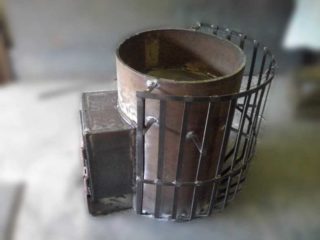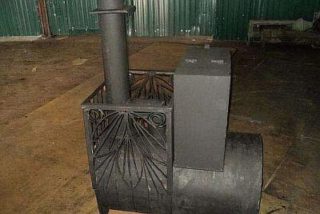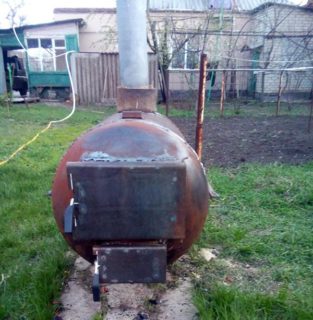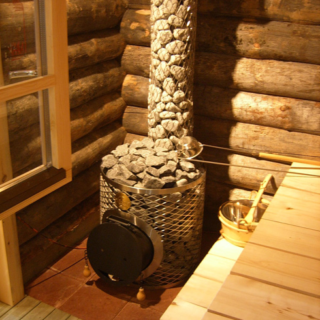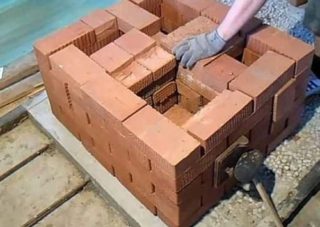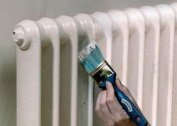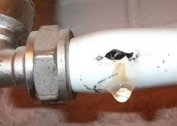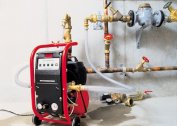The classic Russian bath is still very popular among the owners of country houses and cottages. Before starting work, it is important to determine the design of the future structure and choose the right one. The modern user is offered two options: a brick heater or a homemade metal stove for a bath. Many owners of suburban estates prefer the second option as the cheapest and easiest to implement.
Advantages and disadvantages of steel furnaces
The rejection of the brick option and the choice of a metal sample is due to the following advantages of this design:
- compactness;
- lack of need to equip the foundation base for a home-made steel furnace;
- the ability to maintain combustion at a constant level;
- the permissibility of using inexpensive materials at hand.
An iron stove for a bath does not require the special skills that are needed when laying the simplest brick structure. The small dimensions of such a device allow you to install it even in a small steam room. If you need to make a base for it, you can choose the simplest type of lightweight foundation. All of these advantages will simplify the installation work itself and will save time spent on their implementation.
During the operation of the iron furnace for the bath, the control of the combustion process and the removal of combustion products is simplified.
What is required
Regardless of the chosen embodiment, the following materials will need to be prepared to assemble the furnace:
- blanks of sheet steel;
- bar 10 mm thick;
- pieces of metal pipe;
- several latch-latches on the combustion chamber door;
- steel doors;
- workpieces of rods for the grate and partitions under the heater;
- water supply tap from the tank.
Sheet steel is taken with a thickness of 8 mm or more. Metal pipes are selected with a wall thickness of 10 mm and a diameter of 40-50 mm. When choosing them, you should focus on a 90-cm length going to the manufacture of a firebox. To build the tank, you will need to prepare a 60-centimeter piece, and a 50-cm pipe is used for the rest of the parts.
In the manufacture of a stove for a bath designed for firewood, the doors of the structure are easy to make on their own. Those who are not completely confident in their abilities are advised to buy a finished cast-iron product. Of the tools for assembly and installation work, a welding machine and a grinding machine will be required.
Types of structures
Before you assemble the stove in the bathhouse with your own hands from metal, you have to decide on the shape of its body. The performance and ease of handling of the unit depend on the correct choice of this indicator. In accordance with this characteristic, home-made stoves are:
- cylindrical shape;
- special figured appearance;
- horizontal execution;
- rectangular.
The last version of the product shape is the most common and therefore selected as the basis for future design. With this configuration, it has maximum rigidity.
The rectangular shape will ensure uniform heating of the entire steel structure and the bath room. When solving the issue with its design, the stability of the position of the furnace on the floor must be taken into account.
Cases of cylindrical or round shape are characterized by low stability. In addition, the design of the product takes into account the thickness of the used tubular blanks, providing maximum thermal return.
In addition to the traditional open design, metal stoves are sometimes made with a small fence made of refractory bricks. It makes sense to enclose the furnace with such a fence - this will allow you to accumulate heat within the chamotte masonry and protect people taking bath procedures from burns. Homemade metal bath stoves have many other designs, once invented by craftsmen.
The simplest solution is to make a heater from an unnecessary metal barrel with thick walls, with the lid and bottom cut off. As a result of refinement, it is possible to obtain a cylindrical billet, up to half the volume, filled with bricks installed on the rib. On top of it, a finished grate of cast iron is laid, and the rest is filled with stones for 2/3 of the total volume. At the end of installation work, the design is supplemented by a chimney and a protective cover.
DIY oven
The procedure for assembling an oven in a bathhouse made of iron is considered on the example of a sample with a closed heater, when using which, to add steam, you will need to open the door. To assemble such a furnace in the indicated sequence, the following operations are performed:
- In a piece of 50 cm pipe, an aperture is made under a 5 × 20 cm blown.
- Inside the workpiece for welding, support brackets are fixed in the form of metal plates with small eyes (they are needed to install the grate).
- Go to the arrangement of the furnace, under which a through hole of 25x20 cm is made.
- To separate the heater from the furnace, the same metal brackets are welded around the circumference.
For the manufacture of a grate and a partition for a heater, pre-cut centimeter-thick rods are used in size. In most cases, even good craftsmen prefer to buy these parts in a ready-made form. All further operations are performed in the following sequence:
- At the other end of the pipe, an opening for cutting out hot steam is cut in its wall.
- Subsequently, the already welded stove is filled with stones suitable for this design.
- In addition, a hole for a chimney pipe is made in the furnace lid.
- At the final stage of the work, the chimney is installed in its intended place.
A self-made oven of a closed design is suitable for a bathhouse fired with firewood. If desired, its scheme can be improved by adding to it a makeshift tank for hot water discharged into the dressing room. To do this, do the following operations:
- A piece of large diameter pipe is taken, to which the bottom is welded on one side, and a finished valve is mounted a little higher in the wall.
- A lid is made on top, the base of which is cut into two parts.
- In one, an opening is made for a chimney that heats the water, after which this part is welded on top of the tank.
- The other half of the lid is removable. For ease of use, a handle and fixing loops are welded to it.
Before the manufacture of the furnace, a set of drawings is necessarily prepared, on which all the necessary dimensions and assembly diagram are indicated. This will help to quickly make a design of any complexity.
Open-hearth metal stove
The choice of the design of an open-hearth furnace will greatly simplify all work operations for its assembly. It is even easier to do this if the farm has a metal sheet of the right size. The design is made from a pipe billet divided into two compartments with a previously purchased grate.A firebox is made in its upper part, and the lower one will be used as an ash pan and a blower.
Both compartments are supplemented with doors through which firewood is laid, air is supplied and combustion products are removed. A chimney pipe with a diameter of 100 mm is mounted in the upper end of the pipe billet. On top of an almost finished stove, a metal box is welded into which stones are laid. The chimney elbow can come into contact with them, transferring part of the heat for better heating. The hot water tank in this case is made of a sheet of iron. It is placed directly on the furnace body from any of its sides in accordance with the layout of the steam room or sauna.
After choosing a location, the tank is fixed on top of the body in the form of a kind of “shirt”, after which the water supply and intake pipes are cut into it. For the most convenient and comfortable supply, a heat exchanger is mounted on the chimney pipe. The easiest way to buy a water heater is in the store; in this case, the kit already contains a standard size pipe. Upon completion of the installation of the heat exchanger, the chimney outlet crashes into the tank; while the pipe itself is diverted through a previously prepared hole in the wall and ceiling of the bathhouse. With a significant amount of water, a makeshift tank can act as a heat exchanger.
Brick Wall Open Furnace
Combined structures are characterized by the ability to accumulate heat, increasing the efficiency of the entire unit. This design is based on a typical metal case, inside of which brick walls are laid out. The requirements for the thickness of the shell are not as stringent as a pure metal furnace, so a 2 mm sheet of iron will suffice. For interior decoration of the walls, fireclay chamotte brick is required. It is put on the brand-name mixture purchased, which is intended specifically for this type of brick material. When preparing it from a dry powder, they are guided by the attached instructions.
Before assembling the furnace, a base is prepared for it. To do this, legs with heels are welded to the steel casing, giving the structure greater stability. A solid brick row is laid on them. In oversized structures, it is allowed to do it in half a brick. When arranging the output of the chimney channel, a quarter is used. After laying out the chambers with a blower go to the cast-iron grate, mounted exactly in the middle between the ash pan and the finished firebox.
For registration in the masonry of various openings, metal corners of square section with a size of 20 mm will be required. In the process of laying brick, make sure that the inter-row seams are kept even. Upon reaching the top of the combustion chamber (the level of the heater), a grid of steel rods 12 mm thick is laid on top. In this place, small openings are left on both sides, into which stones are subsequently loaded. The presence of such niches will allow to periodically remove stones and clean from accumulated soot. On them, during bathing procedures, portions of water splash to enhance the heat.
Recommendations of specialists
When choosing an open option with brick walls, the master should be guided by the following considerations:
- the chimney channel in such structures is made as possible with a large number of sharp turns, which contributes to better heat transfer and complete combustion of fuel;
- in the presence of such a lapel up should worry about the arrangement in this place of the revision window with a valve;
- the top row of bricks is necessarily made solid; however, it leaves a small opening for mounting the chimney.
Upon completion of the brickwork, they proceed to welding the walls of the metal casing, which in its purpose resembles a case that borders the entire structure.
